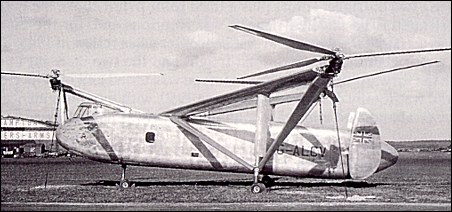|
|
In this helicopter, power from a single engine was transmitted through shafting to three-bladed rotors mounted on outriggers, each at the tip of a triangle. All three turned in the same direction, but their plane of rotation was sufficiently tilted to compensate for torque. Each rotor hub had a control spider which ensured cyclic and collective pitch control. The engine with its distribution gearbox to drive the rotors was situated just behind the cockpit in the fuselage. The fuselage was designed to carry twenty-four passengers in a compartment measuring 5.79 x 2.31 x 1.77 metres.
There was a tricycle landing gear, each leg of which was fitted with an oleo-pneumatic shock absorber.
The prototype, the largest in the world at that date, made its maiden flight in December 1948, but shortly after being displayed at the Farnborough Show it crashed, and work did not start on it again until the Gierva Company, as previously stated, was taken over by Saunders Roe. P.Lambermont "Helicopters and Autogyros of the World", 1958
The Cierva W.11 Air Horse, built in 1948, featured three tri-bladed rotors mounted on outriggers from the fuselage and driven from a centrally-installed engine. Two prototypes were built for the British Ministry of Supply. It could carry 24 passengers. G.Apostolo "The Illustrated Encyclopedia of Helicopters", 1984
The designation W.10 was allocated to a project for a 4/5-seat single-engine helicopter, but the W.11 Air Horse was the largest helicopter in the world when it first flew on 7 December 1948. A single Rolls-Royce Merlin 24 engine of 1208kW was mounted in the fuselage to drive three large three-blade rotors mounted on outriggers projecting from the square fuselage. Twin fins were carried at the end of a mid-mounted tailplane on the rear fuselage and there was accommodation for a crew of three.
As a passenger aircraft the W.11 would have carried 24, but other roles that were envisaged included air ambulance, aerial crane and crop sprayer. In September 1945 Pest Control Ltd had discussed the last possibility with Cierva and the W.11 design was modified to meet this role. As a result, Cierva received a development contract for one W.11 in July 1946, drafted to Specification E.19/46, and a second was ordered in early 1947. Cunliffe-Owen Aircraft Ltd were contracted to build the two aircraft at Southampton/Eastleigh Airport under the technical and financial control of the Cierva company.
With a payload of 3048kg of insecticide the W.11 would have made an impressive sprayer, and following the first flight in December 1948 subsequent tests were promising. The Colonial Office made a grant of GBP45,000 to assist in the development costs since the type offered prospects of overseas use in the spraying role (total Ministry of Supply development costs were estimated at GBP350,000), but before the second W.11 had flown the first crashed on 13 June 1950, killing the three flight test crew members; the second W.11 never flew and was scrapped in 1960. The designation W.11T was allocated to a project for an enlarged W.11 with two 1208kW Rolls-Royce Merlin 502 engines and the W.12 was a projected freighter development with Rolls-Royce Dart turboprops. Neither of these materialised since by that time Cierva, not having used the number W.13, was involved in development of the W.14 which became the Skeeter and was built by Saunders-Roe Ltd. D.Donald "The Complete Encyclopedia of World Aircraft", 1997
 |
Cierva W.11
|
 |
Cierva W.11
|
 |
Cierva W.11
|
 |
Cierva W.11
|
| Technical data for Cierva W.11
Crew: 4-5,
passengers: 24,
engine: 1 x Rolls-Royce Merlin 24 pistone engine, rated at 1208kW,
rotor diameter: 14.33m,
length with rotors turning: 27.0m,
width with rotors turning: 28.96m,
take-off weight: 7938kg,
loaded weight: 5507kg,
max speed: 225km/h,
cruising speed: 153km/h,
service ceiling: 8535m,
range with max fuel: 531km
|
Warning: mysqli_connect(): php_network_getaddresses: getaddrinfo for mysql5.zone.ee failed: Name or service not known in /data03/virt15346/domeenid/www.aviastar.org/htdocs/helicopters_eng/west_w11.php on line 129
Fatal error: Uncaught mysqli_sql_exception: php_network_getaddresses: getaddrinfo for mysql5.zone.ee failed: Name or service not known in /data03/virt15346/domeenid/www.aviastar.org/htdocs/helicopters_eng/west_w11.php:129
Stack trace:
#0 /data03/virt15346/domeenid/www.aviastar.org/htdocs/helicopters_eng/west_w11.php(129): mysqli_connect('mysql5.zone.ee', 'd14657sa18989', Object(SensitiveParameterValue))
#1 {main}
thrown in /data03/virt15346/domeenid/www.aviastar.org/htdocs/helicopters_eng/west_w11.php on line 129
|





